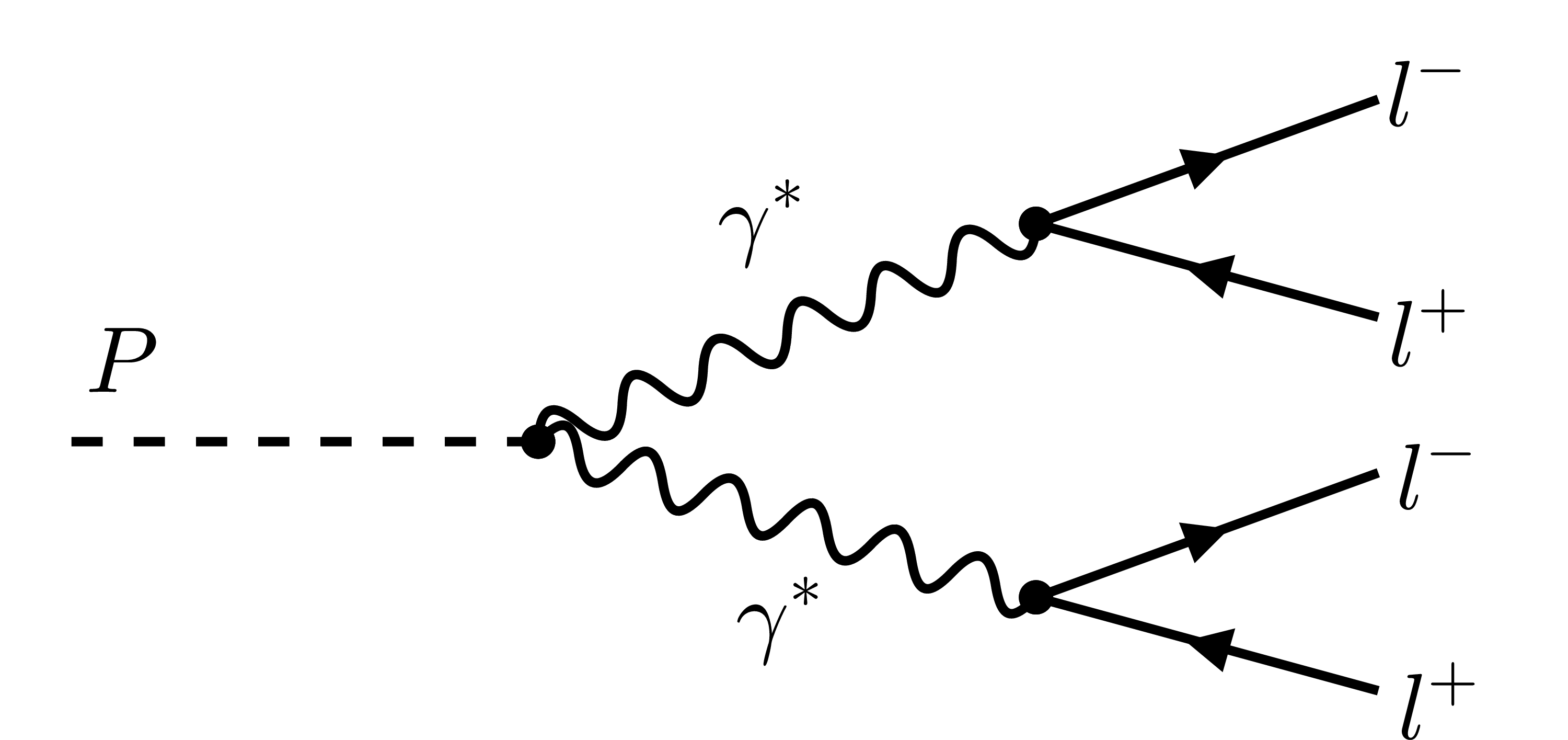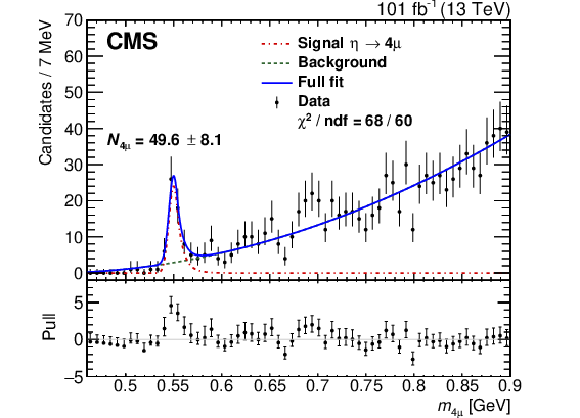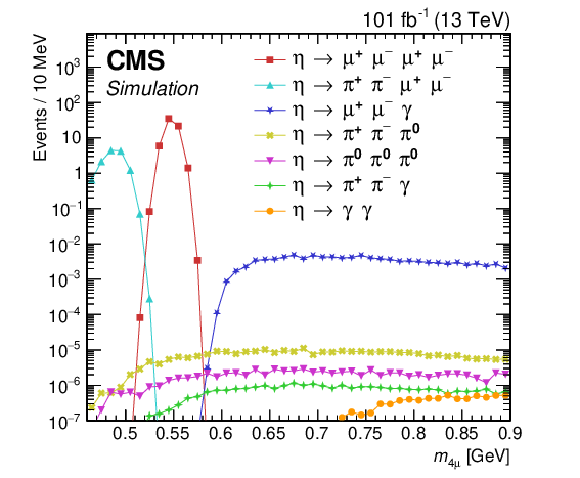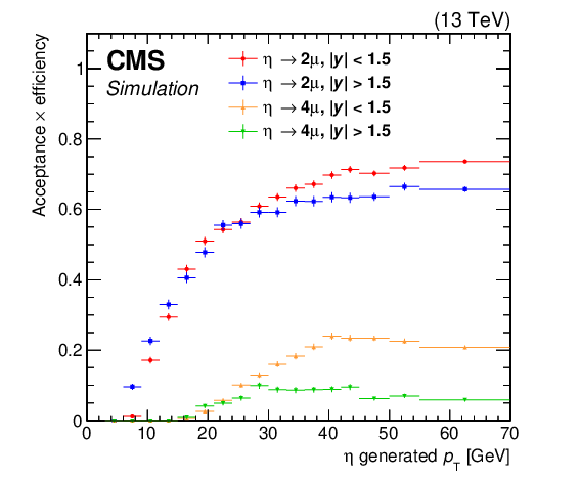

Compact Muon Solenoid
LHC, CERN
| CMS-BPH-22-003 ; CERN-EP-2023-071 | ||
| Observation of the rare decay of the $ \eta $ meson to four muons | ||
| CMS Collaboration | ||
| 8 May 2023 | ||
| Phys. Rev. Lett. 131 (2023) 091903 | ||
| Abstract: A search for the rare $ \eta \to \mu^{+} \mu^{-} \mu^{+} \mu^{-} $ double-Dalitz decay is performed using a sample of proton-proton collisions, collected by the CMS experiment at the CERN LHC with high-rate muon triggers in 2017-2018 and corresponding to an integrated luminosity of 101 fb$ ^{-1} $. A signal having a statistical significance well in excess of 5 standard deviations is observed. Using the $ \eta \to \mu^{+} \mu^{-} $ decay as normalization, the branching fraction $ \mathcal{B}(\eta \to \mu^{+} \mu^{-} \mu^{+} \mu^{-}) = $ (5.0 $ \pm $ 0.8 (stat) $ \pm $ 0.7 (syst) $ \pm $ 0.7 ($\mathcal{B}_{2 \mu}$)) $\times $ 10$^{-9} $ is measured, where the last term is the uncertainty in the normalization channel branching fraction. This is the first measurement of this branching fraction and is found to be in agreement with theoretical predictions. | ||
| Links: e-print arXiv:2305.04904 [hep-ex] (PDF) ; CDS record ; inSPIRE record ; HepData record ; Physics Briefing ; CADI line (restricted) ; | ||
| Figures | |

png pdf |
Figure 1:
Feynman diagram of pseudoscalar decays into four leptons, known as double-Dalitz decays. |

png pdf |
Figure 2:
Distribution of $ m_{2 \mu} $ obtained with the dimuon selection integrated in dimuon $ p_{\mathrm{T}} $ and in three $ p_{\mathrm{T}} $ ranges as indicated in the legend, with the number of events in the selected $ p_{\mathrm{T}} $ ranges multiplied by five for better visibility. |

png pdf |
Figure 3:
Measured $ m_{4 \mu} $ distribution, with the fit result overlaid. The pull distribution in the lower panel is shown relative to the background component of the fit model and defined as $ (\text{Data} - \text{FitBkg}) /\sqrt{\sigma_{\text{Data}}^2 - \sigma_{\text{FitBkg}}^2} $. Uncertainties are statistical only. |

png pdf |
Figure 4:
Comparison of the four-muon $ p_{\mathrm{T}} $ spectrum observed in data with 0.53 $ < m_{4 \mu} < $ 0.57 GeV (black points) and the signal prediction from simulation assuming the observed branching fraction (orange dashed line). Also shown is the predicted background shape, extracted from the mass sideband, normalized to the background fit yield (dotted blue line) and the sum of signal and background predictions (solid red line). |

png pdf |
Figure 5:
Predicted background contributions to the signal mass window, estimated with simplified MC simulations. The $ \eta \to \mu^{+} \mu^{-} \mu^{+} \mu^{-} $ signal is displayed as a benchmark (red squares), followed by various other decay modes of the $ \eta $ meson. The curves are normalized to an integrated luminosity of 101 fb$ ^{-1} $. For unobserved decay modes, the current experimental upper limits are conservatively taken as the reference branching fractions in the estimations, with the exception of the signal channel, where the branching fraction measured in this work is used. |

png pdf |
Figure 6:
The total efficiencies for the four-muon ($ A_{4 \mu}^{\mathrm{i,j}} $, red and blue points) and two-muon ($ A_{2 \mu}^{\mathrm{i,j}} $, orange and green points) decay channels, as functions of the generated meson's $ p_{\mathrm{T}} $ and $ y $, evaluated through MC simulation. |
| Tables | |

png pdf |
Table 1:
Set of dimuon L1 requirements applied in the high-rate triggers. The angular separation between muons in the $ \eta$-$\phi $ plane is defined as $ \Delta R \equiv \sqrt{\smash[b]{(\Delta\eta)^2+(\Delta\phi)^2}} $, where $ \phi $ is the azimuthal angle. The first L1 path requires for each muon $ p_{\mathrm{T}} > $ 4.0 (4.5) GeV in 2017 (2018). The third path imposes separate requirements on each muon $ p_{\mathrm{T}} $. The $ m_{2 \mu} $ column denotes a range of allowed dimuon invariant masses. The charge column indicates if an opposite-sign (OS) requirement exists between muons. The last column reports the fraction of selected events accepted by each path. |
| Summary |
| In summary, the first observation of the $ \eta $ meson's rare double-Dalitz decay to four muons is reported. This is made possible by the use of CMS data collected with high-rate muon triggers at $ \sqrt{s} = $ 13 TeV in 2017 and 2018, corresponding to an integrated luminosity of 101 fb$ ^{-1} $. The branching fraction of the $ \eta \to 4 \mu $ decay is measured relative to the $ \eta \to 2 \mu $ decay, yielding a ratio of branching fractions of (0.86 $ \pm $ 0.14 (stat) $ \pm $ 0.12 (syst)) $\times$ 10$^{-3} $. Using the world average branching fraction value [1] for the normalization channel, the branching fraction of the four-muon decay channel is $ \mathcal{B}(\eta \to \mu^{+} \mu^{-} \mu^{+} \mu^{-}) = $ (5.0 $ \pm $ 0.8 (stat) $ \pm $ 0.7 (syst) $ \pm $ 0.7 ($\mathcal{B}_{2 \mu}$)) $\times$ 10$^{-9} $, where the last term is the uncertainty in the normalization channel branching fraction. This result is in agreement with theoretical predictions [10]. |
| References | ||||
| 1 | Particle Data Group, R. L. Workman et al. | Review of particle physics | Prog. Theor. Exp. Phys. 2022 (2022) 083C01 | |
| 2 | L. G. Landsberg | Electromagnetic decays of light mesons | Phys. Rept. 128 (1985) 301 | |
| 3 | R. Abegg et al. | Measurement of the branching ratio for the decay $ \eta \to \mu^{+} \mu^{-} $ | PRD 50 (1994) 92 | |
| 4 | F. Ambrosino et al. | Observation of the rare $ \eta \to e^{+} e^{-} e^{+} e^{-} $ decay with the KLOE experiment | PLB 702 (2011) 324 | 1105.6067 |
| 5 | BES-III Collaboration | Observation of the double Dalitz decay $ \eta^{'}\to{e}^{+}{e}^-{e}^+{e}^- $ | PRD 105 (2022) 112010 | 2203.12229 |
| 6 | A. Anastasi et al. | Precision measurement of the $ \eta \to \pi^+ \pi^- \pi^0 $ Dalitz plot distribution with the KLOE detector | JHEP 05 (2016) 019 | 1601.06985 |
| 7 | L. Gan, B. Kubis, E. Passemar, and S. Tulin | Precision tests of fundamental physics with $ \eta $ and $ \eta^\prime $ mesons | Phys. Rept. 945 (2022) 1 | 2007.00664 |
| 8 | E. Goudzovski et al. | New physics searches at kaon and hyperon factories | Rept. Prog. Phys. 86 (2023) 016201 | 2201.07805 |
| 9 | M. Knecht, S. Narison, A. Rabemananjara, and D. Rabetiarivony | Scalar meson contributions to $ a_\mu $ from hadronic light-by-light scattering | PLB 787 (2018) 111 | 1808.03848 |
| 10 | R. Escribano and S. Gonzàlez-Solís | A data-driven approach to $ \pi^0 $, $ \eta $ and $ \eta^\prime $ single and double Dalitz decays | Chinese Phys. C 42 (2018) 023109 | 1511.04916 |
| 11 | CMS Collaboration | HEPData record for this analysis | link | |
| 12 | CMS Collaboration | The CMS trigger system | JINST 12 (2017) P01020 | CMS-TRG-12-001 1609.02366 |
| 13 | CELSIUS/WASA Collaboration | Measurement of $ \eta $ meson decays into lepton-antilepton pairs | PRD 77 (2008) 032004 | 0711.3531 |
| 14 | CMS Collaboration | Electron and photon reconstruction and identification with the CMS experiment at the CERN LHC | JINST 16 (2021) P05014 | CMS-EGM-17-001 2012.06888 |
| 15 | CMS Collaboration | Performance of the CMS muon detector and muon reconstruction with proton-proton collisions at $ \sqrt{s}= $ 13 TeV | JINST 13 (2018) P06015 | CMS-MUO-16-001 1804.04528 |
| 16 | CMS Collaboration | Description and performance of track and primary-vertex reconstruction with the CMS tracker | JINST 9 (2014) P10009 | CMS-TRK-11-001 1405.6569 |
| 17 | CMS Collaboration | The CMS experiment at the CERN LHC | JINST 3 (2008) S08004 | |
| 18 | CMS Collaboration | Search for a narrow resonance lighter than 200 GeV decaying to a pair of muons in proton-proton collisions at $ \sqrt{s} = $ 13 TeV | PRL 124 (2020) 131802 | CMS-EXO-19-018 1912.04776 |
| 19 | CMS Collaboration | Data parking and data scouting at the CMS Experiment | CMS Detector Performance Note CMS-DP-2012-022, 2012 CDS |
|
| 20 | CMS Collaboration | Search for narrow resonances in dijet final states at $ \sqrt{s} = $ 8 TeV with the novel CMS technique of data scouting | PRL 117 (2016) 031802 | CMS-EXO-14-005 1604.08907 |
| 21 | CMS Collaboration | Precision luminosity measurement in proton-proton collisions at $ \sqrt{s}= $ 13 TeV in 2015 and 2016 at CMS | EPJC 81 (2021) 800 | CMS-LUM-17-003 2104.01927 |
| 22 | CMS Collaboration | CMS luminosity measurement for the 2017 data-taking period at $ \sqrt{s}= $ 13 TeV | CMS Physics Analysis Summary, 2018 CMS-PAS-LUM-17-004 |
CMS-PAS-LUM-17-004 |
| 23 | CMS Collaboration | CMS luminosity measurement for the 2018 data-taking period at $ \sqrt{s}= $ 13 TeV | CMS Physics Analysis Summary, 2019 CMS-PAS-LUM-18-002 |
CMS-PAS-LUM-18-002 |
| 24 | R. Frühwirth | Application of Kalman filtering to track and vertex fitting | NIM A 262 (1987) 444 | |
| 25 | M. J. Oreglia | A study of the reactions $ \psi^\prime \to \gamma \gamma \psi $ | PhD thesis, Stanford University, SLAC-R-236, 1980 link |
|
| 26 | S. Baker and R. D. Cousins | Clarification of the use of $\chi^2$ and likelihood functions in fits to histograms | NIM A 221 (1984) 437 | |
| 27 | I. Fröhlich et al. | Pluto: A Monte Carlo simulation tool for hadronic physics | PoS ACAT 07 (2007) 6 | 0708.2382 |
| 28 | J. J. Sakurai | Theory of strong interactions | Ann. Phys. 11 (1960) 1 | |
| 29 | T. Sjöstrand et al. | An introduction to PYTHIA 8.2 | Comput. Phys. Commun. 191 (2015) 159 | 1410.3012 |
| 30 | CMS Collaboration | Extraction and validation of a new set of CMS PYTHIA 8 tunes from underlying-event measurements | EPJC 80 (2020) 4 | CMS-GEN-17-001 1903.12179 |
| 31 | GEANT4 Collaboration | GEANT 4$-$a simulation toolkit | NIM A 506 (2003) 250 | |
| 32 | B. Borasoy and R. Nißler | $ \eta,\,\eta{^\prime} \to \pi^+ \ell^+ \ell^- $ in a chiral unitary approach | EPJA 33 (2007) 95 | 0705.0954 |
| 33 | R. Escribano, P. Masjuan, and P. Sanchez-Puertas | The $ \eta $ transition form factor from space- and time-like experimental data | EPJC 75 (2015) | 1504.07742 |

|
Compact Muon Solenoid LHC, CERN |

|

|

|

|

|

|